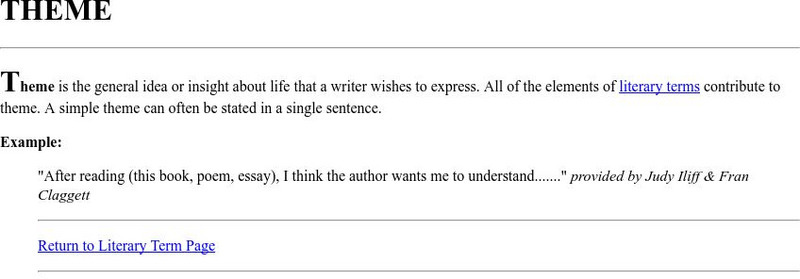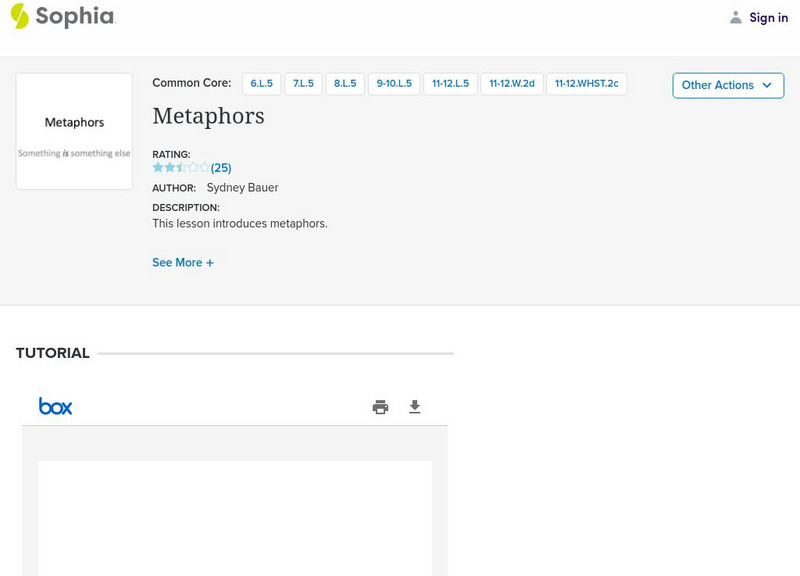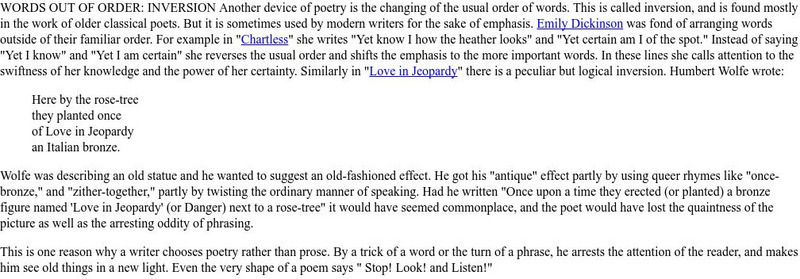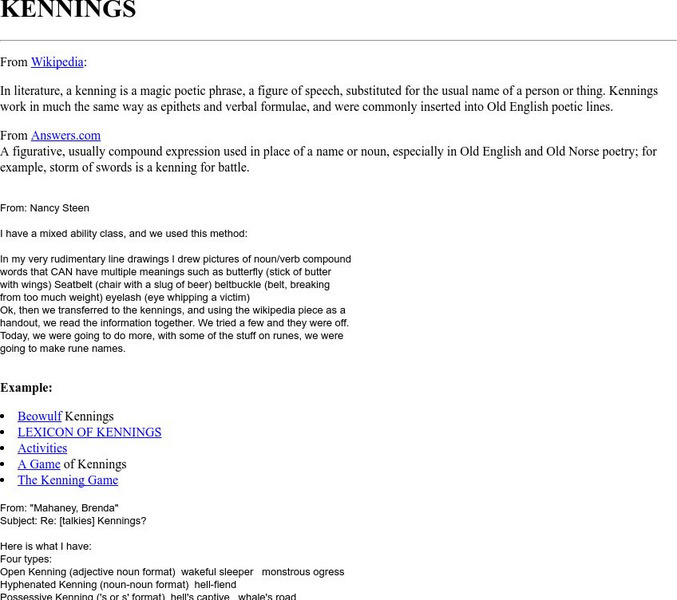PBS
Pbs Learning Media: Their Eyes Were Watching God
This video [4:00] from the American Masters film Zora Neale Hurston: Jump at the Sun examines Zora Neale Hurston and her famous novel "Their Eyes Were Watching God." In this resource, students delve into the novel's title in greater...
Other
St. Edward's University: Devices: Assonance/consonance
Defines and compares the use of assonance and consonance in poetry, with examples.
Emory University
Emory University Writing Center: Ambiguity
Site defines the term ambiguity. Offers explanations of different types of ambiguity, quotes and examples.
Wikimedia
Wikipedia: Understatement
This is an encyclopedia entry for the word "Understatement." It defines the term, provides background information about it, and offers references.
Ted Nellen
Cyber English (By Ted Nellen): Theme
This is a glossary entry for the term "Theme" including a definition and an example.
Ted Nellen
Cyber English (By Ted Nellen): Caesura
This is a glossary entry for the term "Caesura" including a definition and an example.
Other
Bedford/st. Martin's: Lit Gloss
An encyclopedia of literary terms is included on this site. Students can choose different letters of the alphabet to search for literary terms.
Sophia Learning
Sophia: Oxymorons
This slideshow focuses on oxymoron by defining the term, discussing its purpose, and providing examples. L.9-10.5a Figures of Speech
ReadWriteThink
Read Write Think: Stairway to Heaven Examining Metaphor in Popular Music
Contains plans for two lessons that ask students to make connections between literary texts and popular culture texts like song lyrics. After checking popular culture texts for literary elements, these elements are then examined in...
Virtual Salt
Handbook of Rhetorical Devices: Analogy
Defines analogy. Also explains the reasoning behind the multiple levels of comparisons within an analogy. Includes examples and quotes from famous authors.
Other
Mostly Fiction: Latin American Writers and Magic
The writer of this site tells about her experience with reading literature written in the "magical realism" style. It is a personal response to literature, rather than a scholarly analysis, but it is well-written and knowledgable. Many...
abcteach
Abcteach: Personification Form [Pdf]
Form reinforces the concept of personification with examples and room for students to create their own.
Sophia Learning
Sophia: Hyperboles
This tutorial focuses on the use of hyperbole; it defines the term and explains when it is used. It offers two video clips: the first demonstrates the use of hyperbole in song lyrics as it highlights them, and the second shows the use of...
Georgia Department of Education
Ga Virtual Learning: Analyzing Poetry [Pdf]
This resource explains how to analyze a poem for its subject, narrator, tone, diction, and more. "Open" and "closed" poems are defined. Explanation are provided for "metrical feet" and "rhyme scheme" in poetry. William Shakespeare's "My...
Ted Nellen
Cyber English (By Ted Nellen): Stanza
This is a glossary entry for "Stanza" including the definition of the term.
Sophia Learning
Sophia: Metaphors
This slideshow lesson focuses on the literary device metaphor. It defines the term, explains its purpose, and provides examples. W.11-12.2d Lang/Fig/Voc
Ted Nellen
Cyber English (By Ted Nellen): Rhythm and Rhyme
This is a glossary entry for the terms "Rhythm" and Rhyme" including the definition of each and literary examples of each.
Ted Nellen
Cyber English (By Ted Nellen): Asyndeton
This is a glossary entry for the term "Asyndeton" including definitions, an example, and links to more information.
Ted Nellen
Cyber English (By Ted Nellen): Inversion
This is a glossary entry for the term "Inversion" including definition and literary examples.
Ted Nellen
Cyber English (By Ted Nellen): Cacophony
This is a glossary entry for the term "Cacophony" meaning harsh, discordant sounds. It includes a poem entitled "Player Piano" as an example.
Ted Nellen
Cyber English (By Ted Nellen): Chiasmus
This is a glossary entry for the term "Chiasmus" including a definition and examples.
Ted Nellen
Cyber English (By Ted Nellen): Emulation
This is a glossary entry for the term "Emulation" including examples of ways to emulate an author's style as a means of studying it.
Ted Nellen
Cyber English (By Ted Nellen): Kennings
This is a glossary entry for the term "Kennings" including multiple definitions and examples including links to more examples.
Ted Nellen
Cyber English (By Ted Nellen): Nemesis
This glossary entry explains the term "Nemesis" including the definitions, background, and an example.





















